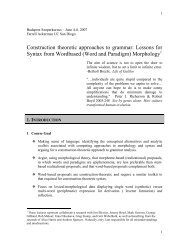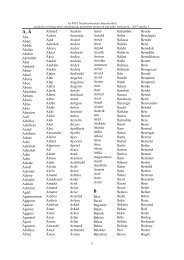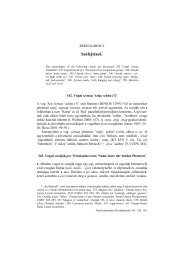Nyelvtudományi közlemények 91. kötet (1990)
Nyelvtudományi közlemények 91. kötet (1990)
Nyelvtudományi közlemények 91. kötet (1990)
Erfolgreiche ePaper selbst erstellen
Machen Sie aus Ihren PDF Publikationen ein blätterbares Flipbook mit unserer einzigartigen Google optimierten e-Paper Software.
CONTEXT MAKES A DIFFERENCE 135<br />
and karakter 'character.' The test sentences required the three différent case<br />
endings val/vel 'with,' ban/ben 'in' and nak/nek 'dative,' each in four différent<br />
contexts: (i) sentence initial, (ii) following a word with a front vowel<br />
alternant of the same suffix as was appropriate for the test word,<br />
(iii) following a word not containing the same suffix as was appropriate for<br />
the test word, and (iv) following a word with the back vowel alternant of<br />
the same suffix as was appropriate for the test word (cf. Kontra e.a.<br />
<strong>1990</strong>). Part of the results, the percentages for suffix choice in front and back<br />
contexts (ii and iv above) are given in (3).<br />
(3) Subjects Reporting Suffixes with Front Vowels<br />
test word test suffix after a word<br />
with front<br />
alternant of<br />
test suffix<br />
after a word<br />
with back<br />
alternant of<br />
test suffix<br />
différence<br />
férfi val/vel 83.05 27.11 55.94<br />
ban/ben 88.13 44.06 44.07<br />
nak/nek 67.79 37.93 29.86<br />
sláger ral/rel 96.61 89.83 6.78<br />
ban/ben 96.61 70.17 26.44<br />
nak/nek 98.30 74.57 23.73<br />
karakter ral/rel 98.30 81.35 16.95<br />
ban/ben 98.30 70.17 28.13<br />
nak/nek 96.61 82.45 14.16<br />
Linking this variation in harmonie suffix choice to regional, social or<br />
stylistic différences seems to be very problematic. Linguistic context, however,<br />
appears to influence speakers' choices to a considérable degree.<br />
In the syntax of Hungárián one finds further examples of context influencing<br />
speakers' language use. In a contrastive analysis of English and<br />
Hungárián relative pronouns Nádasdy (1982) makes the dubious claim that<br />
sentences with and without cataphoric demonstratives such as (4) and (5)<br />
are "perfectly normal" and hâve the same meaning.<br />
(4) Megjött az a kollégám, aki külföldön volt.<br />
arrived that the colleague-my who abroad was<br />
(5) Megjött a kollégám, aki külföldön volt.<br />
In my review of Nádasdy (Kontra 1983) it is shown by means of elicitation<br />
data that the constructions in question do not hâve the same perceived<br />
frequency. 102 subjects rated the relative frequency of 6 pairs of sentences<br />
Nyelvtudományi Közlemények <strong>91.</strong> <strong>1990</strong>.


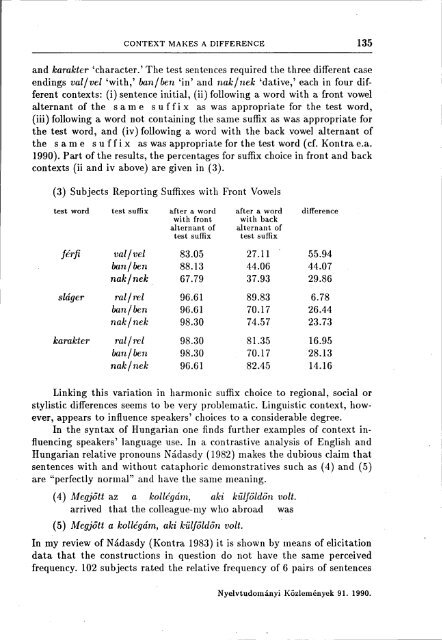

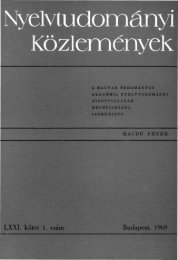

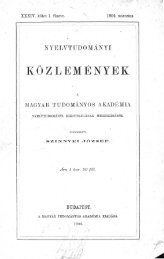
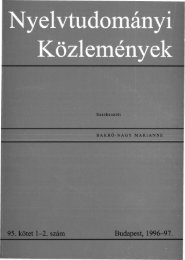
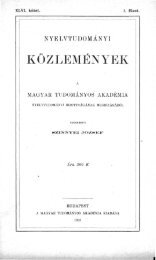
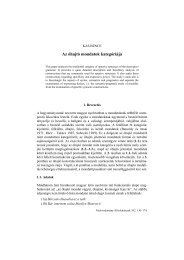
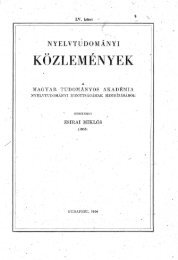
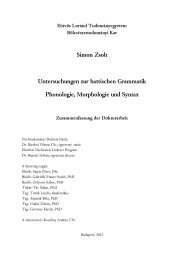
![Gósy Mária: A [p, t, k] mássalhangzók zöngekezdési ideje Bevezetés ...](https://img.yumpu.com/15682849/1/190x245/gosy-maria-a-p-t-k-massalhangzok-zongekezdesi-ideje-bevezetes-.jpg?quality=85)

